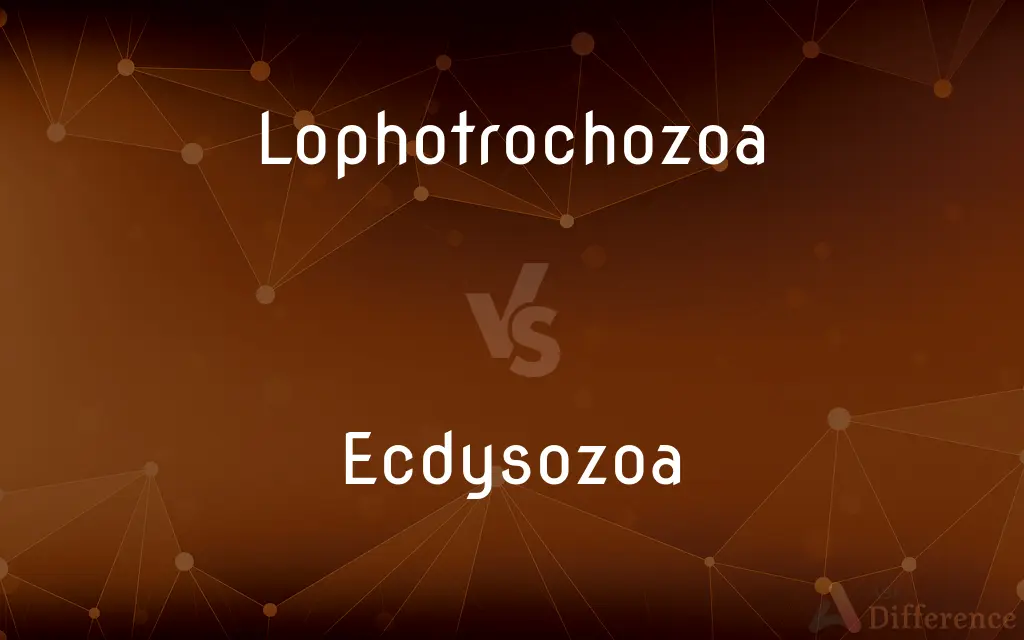Lophotrochozoa vs. Ecdysozoa — What's the Difference?
By Fiza Rafique & Urooj Arif — Updated on March 15, 2024
Lophotrochozoa are a major group of protostome invertebrates characterized by the development of a lophophore or trochophore larvae, while Ecdysozoa are protostomes that undergo ecdysis, shedding their exoskeleton for growth.

Difference Between Lophotrochozoa and Ecdysozoa
Table of Contents
ADVERTISEMENT
Key Differences
Lophotrochozoa encompasses a diverse clade of animals that are primarily identified by their developmental patterns, including the presence of a lophophore (a ciliated feeding structure) in some members and trochophore larvae in others. On the other hand, Ecdysozoa comprises organisms that grow by molting their external cuticle, a process known as ecdysis. This clade includes arthropods, nematodes, and several other invertebrate groups. Ecdysozoans' unique characteristic of shedding their exoskeleton to grow impacts their ecology, behavior, and evolutionary adaptations.
While Lophotrochozoans are characterized by a mix of feeding and developmental mechanisms, Ecdysozoans are unified by a single growth mechanism: ecdysis. This fundamental difference reflects the diverse evolutionary pathways and ecological niches these two groups have adapted to. Lophotrochozoa's development stages, like the trochophore larva, facilitate widespread dispersion in aquatic environments, enhancing genetic diversity and colonization capabilities. Conversely, the necessity of ecdysis in Ecdysozoa demands periodic vulnerability, influencing their behavioral strategies, such as seeking protection during molting periods.
In terms of morphology, Lophotrochozoa show a wide range of body structures, from the soft bodies of mollusks to the segmented forms of annelids. This variability contrasts with the often rigid, segmented exoskeletons of Ecdysozoa, particularly evident in arthropods. The evolutionary pressures faced by these groups have led to the development of complex life cycles and reproductive strategies, showcasing the adaptability and diversity of life.
Reproductive strategies in Lophotrochozoa can vary widely, but many exhibit indirect development, where larval forms undergo significant metamorphosis before reaching grown age. Ecdysozoa, while also diverse in their reproductive strategies, often face the challenge of coordinating growth with the timing of ecdysis, affecting their development and maturation processes. These differences underscore the complex interplay between form, function, and environment in the evolutionary history of these groups.
Both Lophotrochozoa and Ecdysozoa play crucial roles in their ecosystems, with members ranging from primary consumers to top predators. Their distinct characteristics not only highlight the complexity of life's evolutionary tree but also underscore the importance of developmental and morphological diversity in adapting to various ecological niches. Understanding the differences and similarities between these two groups sheds light on the broader patterns of evolution and adaptation among invertebrates.
ADVERTISEMENT
Comparison Chart
Defining Characteristic
Development of a lophophore or trochophore larvae.
Undergoing ecdysis (molting) for growth.
Key Groups
Mollusks, annelids, brachiopods.
Arthropods, nematodes.
Development
Indirect, with significant larval stages.
Growth tied to molting cycles.
Body Structure
Ranges from soft bodies to segmented.
Often features a rigid, segmented exoskeleton.
Ecological Roles
Diverse, including filter feeders and burrowers.
Includes a wide range of consumers and predators.
Reproduction
Often features larval stages with metamorphosis.
Reproduction and growth often coordinated with molting.
Adaptations
Diverse feeding strategies and mobility.
Adaptations to protect during vulnerable molting phases.
Compare with Definitions
Lophotrochozoa
Characterized by diverse body plans and often indirect development.
Annelids show segmented body structures and complex life cycles.
Ecdysozoa
Includes some of the most diverse and numerous species on Earth.
Insects, a subgroup of arthropods, display an immense variety of forms.
Lophotrochozoa
Members display a range of reproductive strategies.
Many mollusks release larvae into the water column, enhancing dispersion.
Ecdysozoa
Features a variety of reproductive and developmental strategies.
Nematodes can have complex life cycles involving multiple hosts.
Lophotrochozoa
Adapted to a variety of ecological niches.
Some annelids are adapted to burrowing, playing key roles in soil aeration.
Ecdysozoa
Exhibits adaptations for protection during molting.
Many arthropods seek sheltered places to molt, avoiding predators.
Lophotrochozoa
A group of invertebrates with either a lophophore feeding structure or trochophore larval stage.
Mollusks like snails exhibit trochophore larvae during development.
Ecdysozoa
Protostomes that grow by shedding their exoskeleton, known as ecdysis.
Arthropods like spiders undergo molting to increase in size.
Lophotrochozoa
Includes species that are pivotal for aquatic ecosystem functions.
Brachiopods filter feed, contributing to water purification.
Ecdysozoa
Members are found in almost every habitat on Earth.
Arthropods are adaptable, inhabiting environments from deep oceans to high mountains.
Lophotrochozoa
Lophotrochozoa (, "crest/wheel animals") is a clade of protostome animals within the Spiralia. The taxon was established as a monophyletic group based on molecular evidence.
Ecdysozoa
Ecdysozoa () is a group of protostome animals, including Arthropoda (insects, chelicerata, crustaceans, and myriapods), Nematoda, and several smaller phyla. They were first defined by Aguinaldo et al.
Common Curiosities
What is Lophotrochozoa?
Lophotrochozoa is a major clade of invertebrates known for members with a lophophore feeding structure or trochophore larvae, including groups like mollusks and annelids.
What defines Ecdysozoa?
Ecdysozoa are invertebrates that undergo ecdysis, or molting, to grow, including arthropods and nematodes.
Why is molting significant for Ecdysozoans?
Molting allows Ecdysozoans to grow and sometimes change their form significantly, which is crucial for their development and reproduction.
Can you give an example of a lophophore?
Brachiopods, which are part of Lophotrochozoa, have a lophophore used for filter feeding.
How diverse are Ecdysozoans?
Ecdysozoans are highly diverse, with species adapted to virtually every ecological niche on Earth.
What ecological roles do Lophotrochozoans play?
They play varied roles, from filter feeding to predation, in their ecosystems.
How do Lophotrochozoa and Ecdysozoa differ in growth?
Lophotrochozoans grow continuously, while Ecdysozoans must periodically shed their exoskeleton to increase in size.
Can you give examples of Lophotrochozoan animals?
Examples include mollusks like snails and cephalopods, and annelids like earthworms.
What types of organisms are found in Ecdysozoa?
Ecdysozoa includes arthropods, such as insects and crustaceans, and nematodes, like roundworms.
How do Lophotrochozoa and Ecdysozoa differ in their developmental processes?
Lophotrochozoa develop from trochophore larvae without molting, while Ecdysozoa undergo distinct developmental stages with molting.
What is ecdysis in Ecdysozoa?
Ecdysis is the process of shedding the external exoskeleton to allow for growth in Ecdysozoa.
Share Your Discovery

Previous Comparison
Treat vs. Retreat
Next Comparison
Metro vs. TramAuthor Spotlight
Written by
Fiza RafiqueFiza Rafique is a skilled content writer at AskDifference.com, where she meticulously refines and enhances written pieces. Drawing from her vast editorial expertise, Fiza ensures clarity, accuracy, and precision in every article. Passionate about language, she continually seeks to elevate the quality of content for readers worldwide.
Co-written by
Urooj ArifUrooj is a skilled content writer at Ask Difference, known for her exceptional ability to simplify complex topics into engaging and informative content. With a passion for research and a flair for clear, concise writing, she consistently delivers articles that resonate with our diverse audience.














































